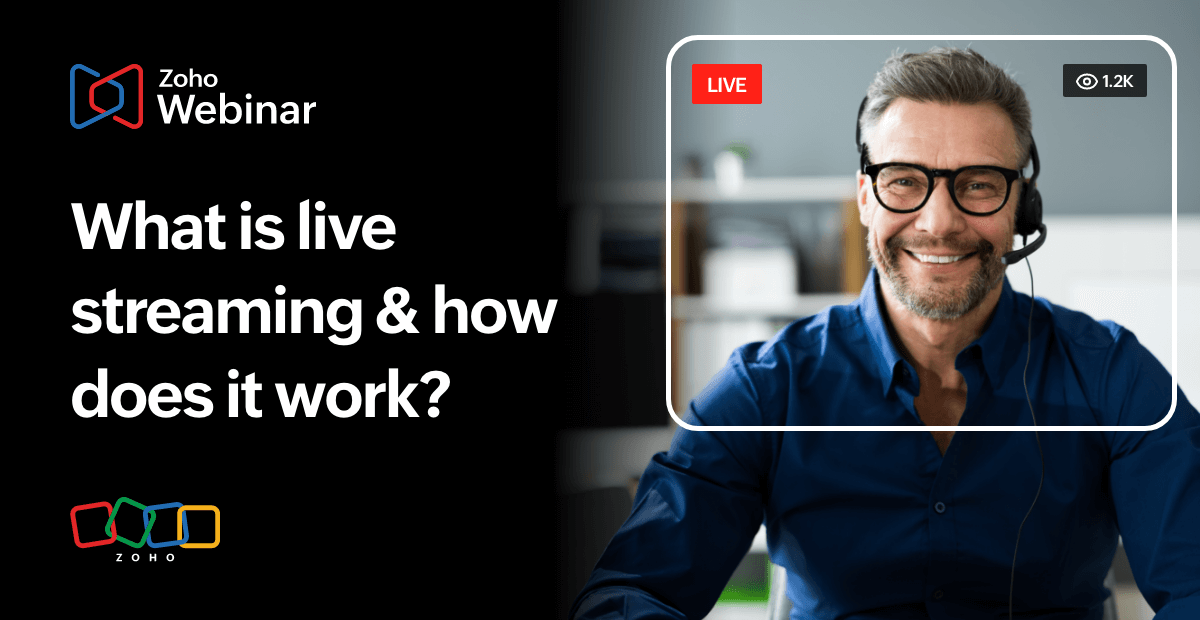- HOME
- What is live streaming & how does it work? - A beginner's guide
What is live streaming & how does it work? - A beginner's guide
- Last Updated : April 3, 2025
- 35 Views
- 3 Min Read
With the influence of social media and streaming platforms steadily growing, live streaming has become more reliable for real-time communication. Whether it's a webinar, virtual training, or product launch, live streaming empowers businesses to engage with their audience instantly.
Businesses need to understand how to leverage live streaming to capitalize on its benefits. In this article, we'll explore what live streaming is, how it works, and how it combines with social media.

What is live streaming?
Live streaming is the process of broadcasting video and audio to a different platform over the internet. The transmission enables the presenter to reach the maximum audience during the live session without having to record and share later. It also enables live interaction between the organizer and attendees, fostering meaningful engagement.
Live streaming can be used for a variety of purposes, including webinars, virtual conferences, and live social media interactions. At its core, live streaming is used to reach a broader audience in real-time right from one platform.
Why is live streaming important?
Live streaming has become a crucial tool for businesses and content creators alike for several reasons:
- Wider reach, yet cost-effective: Live streams can reach a global audience in real-time, eliminating geographical barriers and unforeseen spending. They reduce the costs associated with physical venues, travel, and logistics.
- Brand awareness: Businesses can showcase their expertise and enhance their brand presence through live sessions. Live interactions foster better audience engagement, making sessions more interactive, dynamic, and memorable.
- Monetization opportunities: Many live streaming platforms allow businesses to monetize live content through ads, sponsorships, and pay-per-view options.
How does live streaming work?
Live streaming involves the transmission of audio and video data over the internet using specialized software and protocols. Now let's break down the process:
- Capturing content: A quality camera records the video while a microphone records the session audio. High-quality equipment enhances the overall quality.
- Encoding and compression: The recorded video and audio are converted into a digital format using an encoder. This process ensures smooth transmission without excessive bandwidth usage.
- Streaming platform: Encoded content is now sent to a streaming platform using protocols like real-time messaging protocol (RTMP) or web real-time communication (WebRTC). These protocols ensure minimal latency and seamless delivery.
- Content distribution: Live stream is distributed across servers and delivered to viewers all around the world via content delivery network (CDN). This helps maintain video quality and reduces buffering issues.
- Viewer playback: Audiences can access the live stream through a web browser, mobile app, or embedded player on a website. Interactive features like live chat, Q&A sessions, and reactions enhance overall engagement.
Webinars and live streaming
Webinars are one of the most effective uses of live streaming technology. They allow businesses to conduct virtual conferences, training sessions, and panel discussions while engaging with an audience.
With an intuitive webinar software like Zoho Webinar, businesses can schedule, host, and record live sessions seamlessly. Features like screen sharing and analytics make webinars an indispensable tool for education and marketing.
Social media live streaming
Social media platforms have become key players in live streaming, allowing businesses and individuals to reach their target audience effortlessly in just a few clicks. Here’s how different platforms facilitate live streaming:
- YouTube Live
YouTube Live enables businesses to broadcast live events, webinars, and Q&A sessions. With features like live chat, super chats, and monetization options, YouTube Live is an ideal platform for engaging large audiences. - LinkedIn Live
LinkedIn is designed for professionals and businesses looking to share industry insights, product launches, and corporate events. Live streaming on LinkedIn helps build thought leadership and connect with a professional audience in real time. - Facebook Live
Facebook Live is widely used for casual and business-oriented streaming. It allows direct interaction through comments, reactions, and shares, making it effective for audience engagement and community building. - Custom streaming platforms
Some of the best webinar software in the market, like Zoho Webinar, offers the option for businesses to stream to users' choice of social media right from the webinar platform.
Wrapping up
Live streaming is an essential communication tool in the digital landscape. It provides a platform for businesses, educators, and content creators to connect with their audiences. With the right webinar software, organizations can leverage live streaming to boost engagement, drive sales, and expand their reach. As technology continues to evolve, live streaming will remain a strong force in content delivery and online interaction.
Get started with Zoho Webinar and start live streaming today.
 Swarna Rajan
Swarna RajanSaaS content marketer specializing in all things online collaboration—meetings, webinars, and more! Feel free to strike up a conversation about art, cinema, or history.